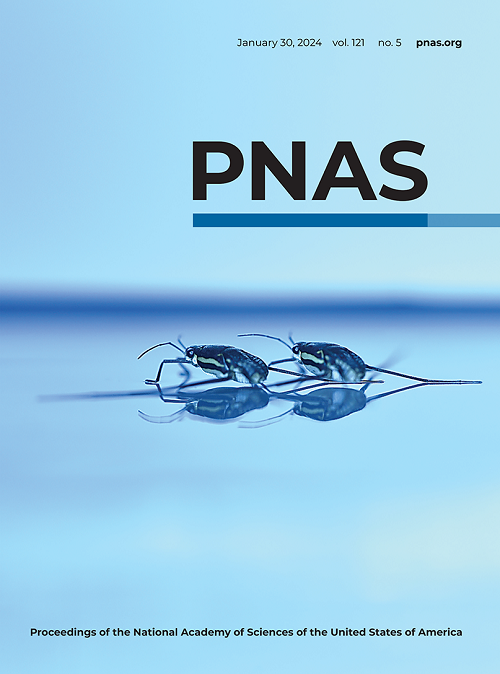TaHSP18.6 and TaSRT1 interact to confer resistance to Fusarium crown rot by regulating the auxin content in common wheat.
IF 9.4
1区 综合性期刊
Q1 MULTIDISCIPLINARY SCIENCES
Proceedings of the National Academy of Sciences of the United States of America
Pub Date : 2025-07-09
DOI:10.1073/pnas.2500029122
引用次数: 0
Abstract
Fusarium crown rot (FCR) is one of the most serious soil-borne diseases in common wheat and has caused major wheat yield losses worldwide. Here, we identified an 18.6 kDa heat shock protein gene (TaHSP18.6) through combining a transcriptome analysis and a genome-wide association study. We verified the positive role of TaHSP18.6 in regulating wheat FCR resistance using ethyl methanesulfonate (EMS) mutants and genetic transformation. Next, we screened a lysine deacetylase sirtuin-like (TaSRT1) to determine its potential interaction with TaHSP18.6. We demonstrated that TaSRT1 deacetylated TaHSP18.6 and thereby inhibited TaHSP18.6 protein accumulation. Haplotype analysis revealed that the K171M substitution of TaHSP18.6 generated a susceptible haplotype TaHSP18.6M171 in wheat, and mass spectrometry results implied that K171 is a key lysine acetylation site. We confirmed the differential acetylation level between TaHSP18.6K171 and TaHSP18.6M171 by TaSRT1. Analysis of overexpression lines and EMS mutants showed that TaSRT1 negatively regulated wheat FCR resistance. Meanwhile, we identified that TaHSP18.6 interacted with an auxin-responsive protein IAA1 (TaIAA1) that negatively regulated FCR resistance. TaHSP18.6 overexpression and TaSRT1 mutation significantly increased the auxin content. Exogenous application of auxin substantially enhanced wheat FCR resistance. Taken together, we proposed a TaSRT1-TaHSP18.6 model regulating FCR resistance possibly through mediating TaIAA1 to change the endogenous auxin content in wheat plants.TaHSP18.6和TaSRT1相互作用,通过调控小麦生长素含量,赋予小麦对枯萎病的抗性。
镰刀菌冠腐病(Fusarium crown rot, FCR)是小麦最严重的土传病害之一,在世界范围内造成了重大的小麦产量损失。在这里,我们通过结合转录组分析和全基因组关联研究,鉴定了一个18.6 kDa的热休克蛋白基因(TaHSP18.6)。利用甲基磺酸乙酯(EMS)突变体和遗传转化验证了TaHSP18.6基因在调节小麦FCR抗性中的积极作用。接下来,我们筛选赖氨酸去乙酰化酶sirtuin样(TaSRT1)以确定其与TaHSP18.6的潜在相互作用。我们证明了TaSRT1使TaHSP18.6去乙酰化,从而抑制了TaHSP18.6蛋白的积累。单倍型分析显示,用K171M取代TaHSP18.6,在小麦中产生一个易感单倍型TaHSP18.6 m171,质谱分析结果表明K171是赖氨酸乙酰化的关键位点。我们通过TaSRT1证实了TaHSP18.6K171和TaHSP18.6M171之间乙酰化水平的差异。对过表达系和EMS突变体的分析表明,TaSRT1负向调控小麦的FCR抗性。同时,我们发现TaHSP18.6与生长素反应蛋白IAA1 (TaIAA1)相互作用,负向调节FCR抗性。TaHSP18.6过表达和TaSRT1突变显著增加了生长素含量。外源施用生长素可显著增强小麦抗FCR能力。综上所述,我们提出了一个TaSRT1-TaHSP18.6模型,该模型可能是通过介导taaa1改变小麦植株内源生长素含量来调节FCR抗性的。
本文章由计算机程序翻译,如有差异,请以英文原文为准。
求助全文
约1分钟内获得全文
求助全文
来源期刊
CiteScore
19.00
自引率
0.90%
发文量
3575
审稿时长
2.5 months
期刊介绍:
The Proceedings of the National Academy of Sciences (PNAS), a peer-reviewed journal of the National Academy of Sciences (NAS), serves as an authoritative source for high-impact, original research across the biological, physical, and social sciences. With a global scope, the journal welcomes submissions from researchers worldwide, making it an inclusive platform for advancing scientific knowledge.

 求助内容:
求助内容: 应助结果提醒方式:
应助结果提醒方式:


